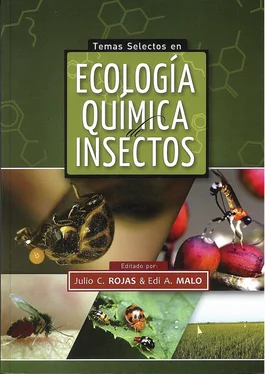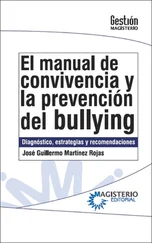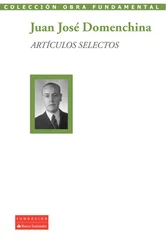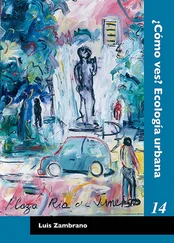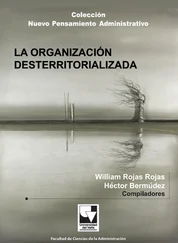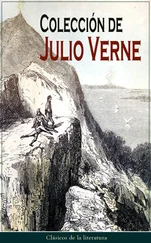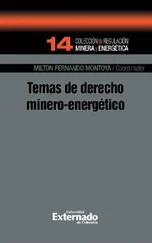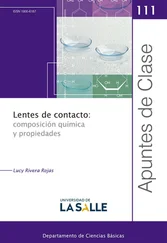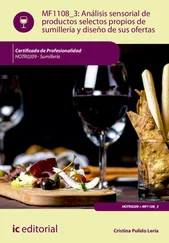KRAMER, E. 1976. The orientation of walking honeybees in odour fields with small concentration gradients. Physiol. Entomol . 1: 27-37.
KROKOS, F. D., KONSTANTOPOULOU, M. A. & MAZOMENOS, B. E. 2001. Alkadienes and alkenes, sex pheromone components of the almond seed wasp Eurytoma amygdale . J . Chem. Ecol . 27: 2169-2181.
LEAL, W. S., SHI, X., NAKAMUTA, K., ONO, M., & MEINWALD, J. 1995. Structure, stereochemistry, and thermal isomerization of the male sex pheromone of the longhorn beetle Anaglyptus subfasciatus. Proc.Natl.Acad. Sci.U.S.A. 92: 1038-1042.
LEAL, W. S., PARRA-PEDRAZZOLI, A. L., COSSÉ, A. A., MURATA, Y., BENTO, J. M. S., & VILELA, E. F. 2006. Identification, synthesis and field evaluation of the complete sex pheromone from the citrus leafminer, Phyllocnistis citrella . J. Chem. Ecol. 32: 155-168.
MALO, E. A., CRUZ-LÓPEZ, L., TOLEDO, J., DEL MAZO, A., VIRGEN, A., & ROJAS, J. C. 2005. Behavioral and electrophysiological responses of the Mexican fruit fly (diptera: Tephritidae) to guava volatiles. Florida Entomol . 88: 364-371.
MALOSSE, C., RAMIREZ-LUCAS P., ROCHAT D., MORIN J. P. 1995. Solid-phase microextraction, an alternative to study of airborne pheromones of insects ( Metamasius hemipterus , Coleoptera: Curculionidae). J. High Resol. Chromatogr . 18: 669-671.
MANKIN, R. W., & HAGSTRUM, D. W. 1995. Three-dimensional orientation of male Cadra cautella (Lepidoptera: Pyralidae) flying to calling females in a windless environment. Environ. Entomol . 24: 1616-1626.
MARTIN, P., & BATESON, P. 1993. Measuring Behaviour: An Introductory Guide . 2nd. Cambridge University Press, Cambridge.
MCINDOO, N. E. 1926. An insect olfactometer. J. Econ. Entomol. 19: 545-571.
MCLAFFERTY, F. W., & TURECEK, F. 1993. Interpretation of Mass Spectra . 4 thed. University Science books. Mill Valley.
MCMAHON, C., GUERIN, P. M., & SYED, Z. 2001. Octen-3-ol, isolated from bont ticks attracts Amblyomma variegatum. J. Chem. Ecol . 27: 471-486.
MEIERHENRICH, U. J., NGUYEN, M. J., BARBIER, B., BRACK, A., & THIEMAN, W. H.-P. 2003. Gas chromatographic separation of saturated aliphatic hydrocarbon enantiomers on permethylated β-cyclodextrin. Chirality 15: S13-S16.
MILLAR, J. G., & SIMS, J. J. 1998. Preparation, cleanup, and preliminary fractionation of extracts, pp. 137, en Millar, J. G., & Haynes, K. F. (eds.), Methods in Chemical Ecology , vol. 1. Kluwer Academic Publishers, Norwell.
MOORHOUSE, J. E., YEADON, R., BEEVOR, P. S., & NESBITT, B. F. 1969. Method for use in studies of insect chemical communication. Nature 223: 1174-1175.
MORI, K. 1989. Synthesis of optically active pheromones. Tetrahedron 45: 3233-3298.
PAWLISZYN, J. 1997. Solid Phase Microextraction. Theory and Practice . Wiley-VCH, New York.
PETSCHEN, I., PARRILLA, A., BOSCH, M. P., AMELA, C., BOTAR, A. A., CAMPS, F., & GUERRERO, A. 1999. First total synthesis of the sex pheromone of the oleander scale Aspidiotus nerii : An unusual sesquiterpenic functionalized cyclobutane. Chem. Eur. J . 5: 3299-3309.
RILEY, J. R. 1993. Flying insects in the field, pp. 1-15, en Wratten, S. D. (ed.), Video Techniques in Animal Ecology and Behaviour. Chapman & Hall, London.
RILEY, J. R., SMITH, A. D. & BETTANY, B. W. 1990. The use of video equipment to record in three dimensions the flight trajectories of Heliothis armigera and other noctuids at night. Physiol. Entomol . 15: 73-80.
ROELOFS, W. L. 1984. Electroantennogram assays: Rapid and convenient screening procedures for pheromones, pp. 131-159, en Miller, T., & Hummel, H. (eds.), Techniques in Pheromone Research. Springer-Verlag. New York.
ROCCA, J. R., TUMLINSON, J. H., GLANCEY, B. M., LOFGREN, C. 1983. The queen recognition pheromone of Solenopsis invicta , preparation of (E)-6(1-pentenyl)-2H-pyran-2-one. Tetrahedron Lett . 24: 1889-1892.
ROJAS J. C., WYATT, T. D., BIRCH, M. C. 2000. Flight and oviposition behavior toward different host plant species by the cabbage moth, Mamestra brassicae (l.) (Lepidoptera: Noctuidae). J. Insect Behav. 13: 247-254.
ROJAS, J. C., CRUZ-LOPEZ, L., MALO, E. A., DIAZ-GOMEZ, O., CALYECAC, G. & CIBRIAN-TOVAR, J. 2006. Identification of the sex pheromone of Copitarsia decolora (Lepidoptera: Noctuidae). J. Econ. Entomol. 99: 797-802.
RUIZ-MONTIEL, C., GARCIA-COAPIO, G., ROJAS, J. C., MALO, E. A., CRUZ-LOPEZ, L., DEL REAL, I., & GONZALEZ-HERNANDEZ, H. 2008. Aggregation pheromone of the agave weevil, Scyphophorus acupunctatus . Entomol. Exp. Appl . 127: 207-217.
SCASCIGHINI, N., MATIACCI, L., D’ALESSANDRO, M., HERN, A., SYBILLEAND, A. & DORN, S. 2005. New insight in analyzing parasitoid attracting synomones: early volatile emission and use of stir bar sorptive extraction. Chemoecology 15: 97-104.
SCHNEIDER, D. 1957. Electrophysiologische untersuchungen von chemo-und machanorezeptoren der antennen des seidenspinners Bombyx mori l. Z. Vergl. Physiol . 40: 8.
SCHNEIDER, D., LACHER, V. & KAISSLING, K.-E. 1964. Die Reaktionsweise und das Reaktionsspektrum von Riechzellen bei Antheraea pernyi (Lepidoptera, Saturniidae). Z. Vergl. Physiol . 48: 632-662.
SCHRECK, C. E., SMITH, N., CARLSON, D. A., PRICE, G. D., HAILE, D., & GODWIN, D. R. 1981. A material isolated from human hands that attracts female mosquitoes. J. Chem. Ecol . 8: 429-438.
SEIDELMANN, K., LUBER, K., & JOERG FERENZ, H. 2000. Analysis of release and role of benzyl cyanide in male desert locusts, Schistocerca gregaria . J. Chem. Ecol. 26: 1897-1910.
STEWART-JONES, A. & POPPY, G. M. 2006. Comparison of glass vessels and plastic bags for enclosing living plant parts for headspace analysis, J. Chem. Ecol .: 845-864.
THOLL, D., BOLAND, W., HANSEL, A., LORETO, F., ROSE, U. S. R. & SCHNITZLER, J. P. 2006. Practical approaches to plant volatile analysis. Plant J . 45: 540-560.
TØMMERÁS, B. A. & MUSTAPARTA, H. 1987. Chemoreception of host volatiles in the bark beetle Ips typographus . J. Comp. Physiol . A 161: 705-719.
VARLEY, M. J., COPLAND, M. J. W., WRATTEN, S. D. & BOWIE, M. H., 1993. Parasites and predators, pp. 33-63, en Wratten, S. D. (ed.), Video Techniques in Animal Ecology and Behaviour . Chapman & Hall, London.
VALLAT A, GU H, & DORN S. 2005. How rainfall, relative humidity and temperature influence volatile emissions from apple trees in situ. Phytochemistry 66: 1540-1550.
VAN DER PERS, J. N. C., & LOFSTEDT, C. 1983. Continuous single sensillum recording as a detection method for moth pheromone components in the effluent of a gas chromatograph. Physiol. Entomol . 8: 203-211.
WADHAMS, L. J. 1982. Coupled gas chromatography-single cell recording. A technique for use in the analysis of insect pheromones. Z. Naturforsch . 37c, 947-952.
WEISSBECKER, B., HOLIGHAUS, G., & SCHUTZ, S. 2004. Gas chromatography with mass spectrometric and electroantennographic detection: analysis of wood odorants by direct coupling of insect olfaction and mass spectrometry. J. Chromatogr. A 1056: 209-216.
WILLIAMS, K. R., & KING, R. W. 1990. The Fourier transform in chemistry-NMR. J. Chem. Educ. 67: 125-138.
WILLIS M. A., & BAKER T.C. 1994. Behaviour of flying oriental fruit moth males during approach to sex pheromone sources. Physiol. Entomol . 19: 61-69.
WIBE, A., BORG-KARLSON, A. K., NORIN, T., & MUSTAPARTA, H. 1997. Identification of plant volatiles activating single receptor neurons in the pine weevil ( Hylobius abietis ). J. Comp. Physiol. A 180: 585-595.
Читать дальше
